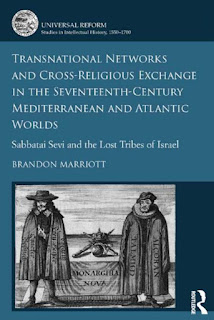Book Review - 'Transnational Networks and Cross-Religious Exchange in the Seventeenth-Century Mediterranean and Atlantic Worlds: Sabbatai Sevi and the Lost Tribes of Israel' by Brandon Marriott
This review was first published in Quaker Studies (Volume 21, Issue 2, 2016)
In this
detailed and interesting book, Brandon Marriott attempts to trace the
transmission of news and rumours across Europe, the Levant and the Americas
between 1648 and 1666 in the context of heightened Jewish messianic and
Christian apocalyptic expectations. He shows how these stories and rumours were
often transformed as they were transmitted and how their reception and
interpretation differed in specific geographical locations and religious
communities. Marriott notes that ‘historians know a good deal about the global
flow of trade, but are just beginning to consider the global circulation of
information’ (p.134). His work seeks to contribute to this emerging research
and ‘responds to the calls by historians for the study of history from a larger
perspective’ (p.8). The book is written in a dense but accessible style and is
primarily addressed to an academic audience. It will be of particular interest
to scholars of history, religious ideas, interfaith relations and print culture
within the early modern period. The book includes an introduction and
conclusion, four main chapters, one of which focuses explicitly on a Quaker
theme, a concise index, an extensive bibliography of archival, primary and
secondary sources, and a helpful parallel timeline covering each of the main
regions considered (the Americas, Iberia and Italy, Northern Europe and the
Levant). The four central chapters of the book each deal with a specific case
study. Chapter one explores claims emerging in the late 1640s that the Lost
Tribes of Israel had been discovered hidden in the Jungles of South America.
Chapter two focuses on the story which circulated in the late 1650s about the
‘Quaker messiah’ James Nayler. Chapter three considers the rumour that spread widely
during the mid-1660s that Mecca had been sacked by the Lost Tribes of Israel.
Finally, chapter four addresses the story of Sabbatai Sevi, a Sephardic rabbi
living in the Ottoman Empire who claimed to be the Jewish messiah but later
converted to Islam.
Marriott’s
careful plotting of information transmission during this period reveals a
number of important insights. He notes how a vigorous print culture, the
emergence of a news industry and the development of global mercantile and
scientific networks enabled a major expansion of the production, transmission
and circulation of information. Indeed, this seems to have resulted in a
bewildering experience of information overload, where a deluge of news and
rumours often proved disorientating for its recipients. The circulation of misinformation
was particularly pervasive at this time and could link individuals and groups
across national, religious and continental divides. This included ‘the
intertwining of Jewish, Christian and Islamic eschatological beliefs against
the background of an increasingly global exchange of news and rumours’ (p.132).
However, direction of travel and influence were not symmetrical. Marriott
concludes that, while news from the Ottoman Empire spread across Europe, news
from Europe and the Americas was less likely to travel in the other direction.
Similarly, he concludes that events in the Jewish world often had a strong
impact on Christian communities, whereas Jews appeared to have been relatively
unaffected by news coming from the Christian world. In addition, the way news
was received and interpreted depended to a large degree on the characteristics
of local religious cultures. Amsterdam was a place of religious toleration, and
so information could be discussed openly by Jews and Christians and such
cross-religious interactions promoted millenarian and messianic ideas. In Italy, on the other hand, such information was interpreted quite differently because Italian Catholicism was not inclined
to apocalyptic speculation. In Germany, instead of generating excitement, messianic
Jewish rumours provoked great fear, due to the spectre of the ‘Red Jews’ within
German culture, who were regarded as an epochal threat to Christendom.
A key benefit
of conducting history from a larger perspective is that it enables us to see
connections and trends that are not necessarily discernible at the micro-level.
However, such a big picture perspective can also mean that the nuances and
complexities of a particular situation are neglected. Marriot’s treatment of
the James Nayler story reveal this limitation. He helpfully demonstrates how
the story spread more widely within Europe and the Americas than had been
previously thought. However, he tends to take the version of events that was
formulated and circulated by anti-Quaker sources at face value. Indeed, he
suggests that the messianic claim made in Bristol in 1656 may well have been
prompted by the impact of Rosicrucian and Fifth Monarchist ideas on Nayler and
his followers. His justification for this claim is the connection that existed between
Martha Symonds, one of Nayler’s followers, and Giles Calvert, who published
tracts by these groups. This proposition fails to take account of a number of important
factors. Firstly, it under-estimates the fiercely sectarian nature of radical
religion in the 1650s. Quakers defined themselves very clearly over and against
such groups. Secondly, it disregards the fact that Calvert was the principal
publisher of tracts by a whole range of radical religious groups, including those
of Friends. Finally, and perhaps most importantly, it ignores a crucial feature
of early Quaker theology: the belief that Christ had returned in Spirit, was
available to all, and would be revealed in anyone who turned to his inward
teaching and transformative power. Friends proclaimed that Christ was now
appearing in his people and was mobilising them in the Lamb’s War. The idea of
an individual messianic claim was therefore inconsistent with the early Quaker
witness. That said, such a detailed analysis of one particular event is beyond
the scope and purpose of Marriott’s research. For Quaker historians and
theologians, this work offers a valuable insight into the complex cultural and
religious context in which early Quaker apocalypticism developed. In
particular, it should prompt further research into the cross-religious exchange
that took place between Quakers and Jews in the seventeenth century.
Brandon Marriott, Transnational Networks and Cross-Religious
Exchange in the Seventeenth-Century Mediterranean and Atlantic Worlds: Sabbatai
Sevi and the Lost Tribes of Israel (Farham: Ashgate, 2015), pp.xiii +167.
ISBN 9781472435842. Hardback, £65.



Comments
Post a Comment